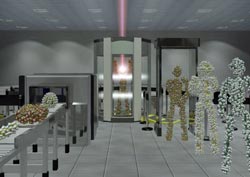The Molecule “Scanner”

CAPTION: An artist’s rendering of molecules being “screened” by a nanoscale terahertz spectrometer<br>
Molecules could soon be “scanned” in a fashion similar to imaging screenings at airports, thanks to a detector developed by University of Pittsburgh physicists.
The detector, featured in a recent issue of Nano Letters, may have the ability to chemically identify single molecules using terahertz radiation—a range of light far below what the eye can detect.
“Our invention allows lines to be ‘written’ and ‘erased’ much in the manner that an Etch A Sketch® toy operates,” said study coauthor Jeremy Levy, professor in the Department of Physics and Astronomy within the Kenneth P. Dietrich School of Arts and Sciences. “The only difference is that the smallest feature is a trillion times smaller than the children’s toy, able to create conductive lines as narrow as two nanometers.”
Terahertz radiation refers to a color range far beyond what the eye can see and is useful for identifying specific types of molecules. This type of radiation is generated and detected with the help of an ultrafast laser, a strobe light that turns on and off in less than 30 femtoseconds (a unit of time equal to 10-15-of a second). Terahertz imaging is commonly used in airport scanners, but has been hard to apply to individual molecules due to a lack of sources and detectors at those scales.
“We believe it would be possible to isolate and probe single nanostructures and even molecules—performing ‘terahertz spectroscopy’ at the ultimate level of a single molecule,” said Levy. “Such resolution will be unprecedented and could be useful for fundamental studies as well as more practical applications.”
Levy and his team are currently performing spectroscopy of molecules and nanoparticles. In the future, they hope to work with a C60, a well-known molecule within the terahertz spectrum.
The oxide materials used for this research were provided by study coauthor Chang-Beom Eom, Theodore H. Geballe Professor and Harvey D. Spangler Distinguished Professor at the University of Wisconsin-Madison College of Engineering.
Additional collaborators include, from Pitt’s Department of Physics and Astronomy, Research Assistant Professor Patrick Irvin, Yanjun Ma (A&S ’13G), and Mengchen Huang (A&S ’13). Also involved was the University of Wisconsin-Madison’s Sangwoo Ryu and Chung Wung Bark.
The paper, “Broadband Terahertz Generation and Detection at 10 nm Scale,” was published in Nano Letters, a publication produced by the American Chemical Society. The research was supported by grants from the United States Air Force Office of Scientific Research and the National Science Foundation.
Contact:
B. Rose Huber
rhuber@pitt.edu
412-624-4356
Cell: 412-328-6008
Media Contact
More Information:
http://www.pitt.eduAll latest news from the category: Physics and Astronomy
This area deals with the fundamental laws and building blocks of nature and how they interact, the properties and the behavior of matter, and research into space and time and their structures.
innovations-report provides in-depth reports and articles on subjects such as astrophysics, laser technologies, nuclear, quantum, particle and solid-state physics, nanotechnologies, planetary research and findings (Mars, Venus) and developments related to the Hubble Telescope.
Newest articles

Webb captures top of iconic horsehead nebula in unprecedented detail
NASA’s James Webb Space Telescope has captured the sharpest infrared images to date of a zoomed-in portion of one of the most distinctive objects in our skies, the Horsehead Nebula….

Cost-effective, high-capacity, and cyclable lithium-ion battery cathodes
Charge-recharge cycling of lithium-superrich iron oxide, a cost-effective and high-capacity cathode for new-generation lithium-ion batteries, can be greatly improved by doping with readily available mineral elements. The energy capacity and…

Novel genetic plant regeneration approach
…without the application of phytohormones. Researchers develop a novel plant regeneration approach by modulating the expression of genes that control plant cell differentiation. For ages now, plants have been the…





















